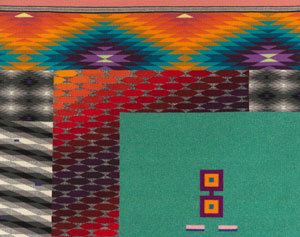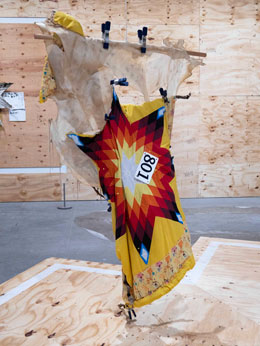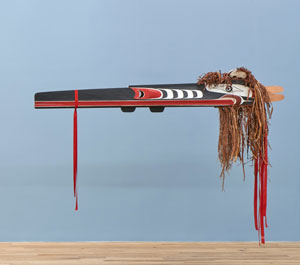Local and Global Color
John Haberin New York City
Melissa Cody, Pacita Abad, and Regina José Galindo
Natalie Ball and Beau Dick
Not so very long ago, diversity in art became not tokenism and liberal pieties, but an opportunity and a necessity. Even then, though, it set barriers and hierarchies.
It demanded attention for the women who labored unrecognized among men. It demanded space for black people once dragged forcibly to the Americas—and Latin Americans driven forcibly from home. It demanded space, too, for a global perspective. What, though, about those who sought their own histories overseas?  And what of those who labored apart within the United States all along? Could they, too, be outsiders?
And what of those who labored apart within the United States all along? Could they, too, be outsiders?
That includes Native Americans like Melissa Cody, Natalie Ball, and Beau Dick, but theirs is not a tidy picture. Cody imagines an all-American childhood, Barbie and Ken included, while Ball identifies as black as well. One could easily mistake Pacita Abad for more of the same, but she draws on six continents far from the American West and has lived in them all. Born in the Philippines, she can almost take diversity for granted. Maybe the secret is not to abolish the white male canon, but to mess things up in the name of art. Regina José Galindo facing down the bulldozers looks ever so easy to categorize by comparison.
Some artists sacrifice themselves for their art. Dick sacrificed his art. He saw his training in wood carving as a gift from his father, his grandfather, and an entire tradition, and he had no interest in wresting it from his Native American ancestry. This was not art for his sake or for art's sake, but for his people. Did that mean reducing it to ashes? So be it.
Barbie as Spider Woman
Give Melissa Cody some credit. When she titles a tapestry I Am Navajo Barbie, she is not cashing in on the movie. She created the work more than ten years ago. She is also just one of three artists boasting of their defiance, their heritage, and nontraditional media at MoMA PS1. They differ only in how far they range beyond those platitudes—and how close to the culture that threatens to swallow up them all. What starts as political correct and artistically pro forma takes on local and global color.
Cody seems happy to limit herself, but her American dream is more than a passing fancy. She calls her show "Webbed Skies" to honor the Spider Woman—not the superhero or the heart of a Latin American novel, but one who descended from the skies to bring weaving to the Navajo/Diné people. Cody's motifs, she says, evoke western mountains, whirling logs, and the snake that threatens to undermine them all. She also remembers her father's descent into Parkinson's disease, and her colorful work could be an act of restitution. So might block letters woven here and there just short of legibility beyond a plea for lost love. If all that seems a lot to ask, it is.
Is there still room for Barbie, and can the work reflect the ambivalence of her hopes? Not really, but she does have a gift for color. Many an artist these days uses hangings to evoke craft traditions, but hers set the elements of tradition just slightly askew. Her patterns depart from symmetry just enough, like in a video game, and her natural and unnatural colors clash and glow. What look at first like Native American blankets in the latest Whitney Biennial end up neither entirely old nor new. They could be equally out of place on tribal lands or in a pricy design outlet.
Pacita Abad is more colorful still, because she works larger and sucks a great deal more into the picture. Single figures can resemble totems, but from what world culture? Denser designs approach abstraction. One might not know it from her opening room, but they also acquire narratives about communities on six continents. She does pick up a needle and thread, but in a collage of found materials and found imagery from a long career. She died in 2004.
Like Enzo Camacho and Ami Lien, Abad survived under the Marcos regime in the Philippines before moving to Thailand and again moving on. Her images of home seem both active and defiant, behind apartment windows or barbed wire. Her totems have heavy eyes and unsightly grins that could attest to sheer fatigue or the demon within. Lady Liberty herself makes an appearance, as LA Liberty. She, too, expresses global displacement, but Abad's New York still looks like home. Her eclecticism, like Cody's ambivalence, may never quite add up, but neither, I suspect, do their own feelings.
Regina José Galindo trades in craft for video and ambivalence for nothing but defiance. She stands naked, proud and impassive, as a bulldozers digging up the Guatemalan earth closes in. If she appears to protest wealthy developers, it is only a metaphor, you see, for decades of civil war. If she also has white gunk all over her upper body, it is just more of the work's chill. It could use some local color. Her art is genuinely unnerving, but what if the bulldozers will not back down?
Inside and out
Art for Natalie Ball looks thrown together at the last minute, on the cheap, but give her time. The details matter to her, as part and parcel of her heritage. Yet that still leaves her at the Whitney wondering who she is and what she has done. Gallery-goers are used by now to art as taking out the garbage. Nairy Baghramian fills the sculptural niches of the Met façade with what look like discards from museum infrastructure, but with brighter colors and less reason for being. For Ball, though, going through the trash takes on the urgency and difficulty of finding herself.
It cannot be easy for a Native American, whose lands have been seized and people have been killed, or an African American, who must plead even now that black lives matter. And Ball identifies as at once black, Modoc, and Klamath, tribes in Northern California and Southern Oregon, where she lives to this day. She says as much in opening wall text, which takes care to appear in English, Spanish, and a native language. Yet it appears on plywood, about as makeshift a material as you can get. More plywood appears as armature for sculpture, as flooring beneath it, and covering an empty wall, like a poor excuse for wallpaper. She is not saying just how it relates to her people, but then there is a lot she does not care to say.
The materials of her sculpture look just as shoddy and just as meaningful, up to a point. They include rawhide, which sounds right, and newsprint, which records things for posterity, but much else as well—including chests of drawers from which she may have drawn more. Collectively, they suggest ritual dress and, a title confirms, tribal dancers, but their colorful patterns give way to smileys.  She might have salvaged them from whatever she had. Unlike the elaborate outfits of Jeffrey Gibson, they could be just as plausibly thrown away. Has everything she valued become empty rituals for empty suits?
She might have salvaged them from whatever she had. Unlike the elaborate outfits of Jeffrey Gibson, they could be just as plausibly thrown away. Has everything she valued become empty rituals for empty suits?
The tallest sculpture seems itself unsure how to stand. Its two poles of polished wood never quite give up their memories of the trees that supplied them. They rise, suspended from the ceiling, but cut the cord and the entirety will collapse. You can wait as long as you like, for Ball has put out plenty of seating, but of gray folding chairs that might easily be on loan for the occasion. They also seem to have fallen where they may. Have a seat where you like.
The title alone seems to have arrived in a hurry. bilwi naats Ga'niipci means we smell like the outside, but Ball does not explain further. Does it mark her people's distance from white America or her distance from them? Is she herself the ultimate outsider artist? Metaphors are elusive, like art. Ball's place at the Whitney is itself both inside and out—the lobby gallery, free to the public because it stands within the museum but outside its ropes.
Art has had no end of installations cobbled together from untraditional materials and popular culture. Who needs another? If it stands out, it is for her lack of certainty. Born in 1980, she can proclaim her identity, but she cannot pin it down. If that leaves me unsatisfied, so be it. For the record, only about six hundred Modoc survive, all in Oregon. And there she stands, inside and out.
The ultimate sacrifice
A documentary about Beau Dick ends a solo show with an excuse to look back—at the deep past and at what one has just seen. It shows him shortly before his death in 2017 in context of others, a bearded activist and chief. When he speaks to the camera, though, he is just an artist entering his sixties and reflecting on his art. A quote on the wall sums up his dual identity. "Our whole culture has been shattered," he says, leaving it "up to the artist to pick up the pieces" and, he adds, to "put them together, back where they belong." At the very least, he can try.
The situation, then, is hopeless but not at all dire, as often happens when it comes to art. In fact, it looks downright cheerful—creative, colorful, and funny. While his masks cover a lot of ground, they give little sense of the artist's development, because he may not have had one. They could be the cast of a single comedy, as "Walas Gwa'yam," or big, great whale. As the film's title has it, he was a "maker of monsters." They just happen to look thoroughly at home on earth.
They include supernatural beings from the Kwakwaka'wakw people in remote western Canada, like the Man and Woman of the Forest. They look, though, not in the least like transcendent beings outside of time and space. They can be human or animal, and one can morph into the other. A reasonably human face sprouts long ears like a cartoon puppy, except that they are also the wings of an eagle rising above.  The long snout of a fox or wolf could be a canoe. A flame seems to rise from another forehead, but it is only a feather, as if the most elaborate of headdresses needs no more to catch fire.
The long snout of a fox or wolf could be a canoe. A flame seems to rise from another forehead, but it is only a feather, as if the most elaborate of headdresses needs no more to catch fire.
They adapt all sorts of materials and purposes, freestanding and along the walls. Some carvings have smooth surfaces, for sharper colors and blacks. Others have a coarser texture, like plaster, that deepens his colors. They could be wearing lipstick or war paint. If that sounds irreverent, it is not a dig at Dick's tribal culture, but a tribute to its punning, cunning irreverence. There, too, living creatures can change shape, and masks can change people.
His monsters might still be a threat, but to Canadian authorities that Dick held responsible for oppression. He saw his work in context of potlatch, a rite of gift giving, where sharing to him approaches socialism. Still, he was not creating idols to a lost cause. Diversity in art these days tends to mean a recovery of identity, as fixed and essential. Dick precludes that, much like Cody at MoMA PS1 or Ball at the Whitney. The motif of a canoe appears as well with Jaune Quick-to-See Smith, defining a history last year at the Whitney, but Dick refuses a proper unfolding.
On film, Dick plays the part of an activist and artist with roots in tradition. In art, he plays the role of a trickster. If the work ever seems light or repetitive, he took his responsibility seriously. He once brought his masks back to his home turf for use in a ceremony—and then he burned them. For an artist, it was the ultimate sacrifice, but not an ending. While he lived, he could always make more.

Melissa Cody ran at MoMA PS1 through September 9, 2024 (with additional work at Garth Greenan through June 15), Pacita Abad through September 2, and José Galindo through August 26. Natalie Ball ran at The Whitney Museum of American Art through February 19, Nairy Baghramian at The Metropolitan Museum of Art through May 28, and Beau Dick Andrew Kreps through May 11.




